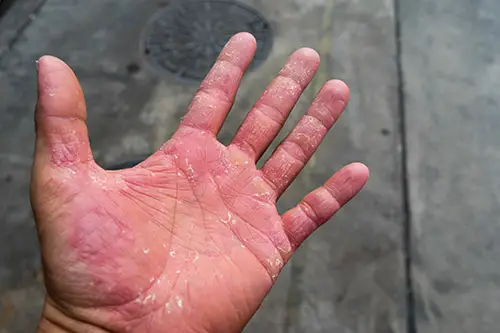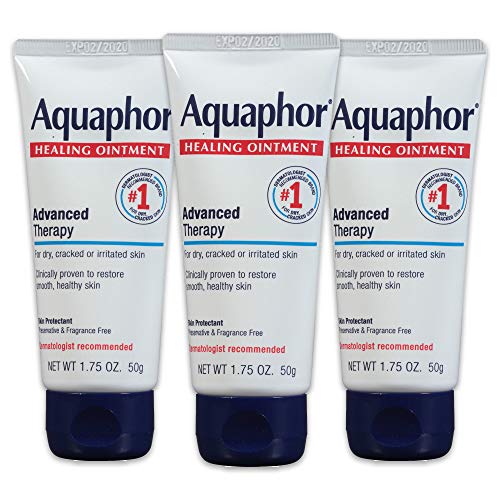Nurses, physicians, paramedics, and other professionals who interact with the public on a daily basis use gloves. On top of that they frequently wash and sanitize their hands, which adds to the dryness of the skin.
During the course of a typical workday, they may be required to wear disposable nitrile, latex, or vinyl gloves for several hours. And it is a cause of concern if the hands acquire dry, itchy, irritated regions or blisters.
Latex gloves typically dry out the hands. It is frequently caused by an irritant, such as chemicals used in the production of hand gloves. And it is this exposure to accelerators and other chemicals used in the production of most latex and non-latex gloves that can cause skin dryness.
Since we know that gloves are essential to keep us safe from contamination and spread of germs, if they cause any sort of issues for you it does become a cause of concern.

The most common problem that is caused is dermatitis which manifests as dry, itchy, irritated skin in the hand. The skin serves as a vital barrier against bloodborne infections and illness.
Individuals who have broken skin as a result of dryness, irritation or allergies are at a higher risk. A skin problem can be excruciatingly irritating and painful, and could result in other major health issues.
So what can you do to prevent hand dryness?
Here, we’ll give you some tips to care for hand dryness caused by latex gloves:
1.) Moisturize your hands using aloe vera
Aloe vera, which is used in many skin care products, contains anti-inflammatory and antibacterial benefits. Apply it after cleaning your hands and before putting on latex gloves.
When applying the aloe vera, make sure your hands are dry and let it do the job. It repairs, smoothes, and soothes your hands cool while you wear latex gloves.
Things to remember-
1.) To avoid drying your hands, avoid using a dryer. Because the heat tends to overdry the hands. It is recommended to wipe them with a paper towel before applying aloe vera.
2.) Don’t let your hands remain dry for long after you wash them, apply aloe vera or any non-alcoholic moisturizer on your hands immediately.
2.) Use oatmeal to soak your hands
Oatmeal has anti-inflammatory properties and is ideal for dry hands. Oatmeal may cure damage to your hands caused by latex gloves, whether you bathe in it or soak your hands in it. Oatmeal moisturizes and softens the skin.
Tips on how to use it-
→ 1 cup rolled oats, powdered in a blender.
→ Fill a sink halfway with lukewarm water.
→ For 10 minutes, soak your hands in the water-filled oats.
3.) Use olive oil
Olive oil is a natural moisturiser rich in vitamin E and vital fatty acids that keeps your hands supple, prevents exposed skin or cracks from infection, and helps to retain moisture. It also aids in the removal of dead and dry skin and protects your hands from infection.
Tip- You can add a few drops of olive oil on your oatmeal mix.
4.) Use accelerator free gloves
In the glove production process, chemical accelerators are used to expedite the linking of rubber molecules in natural rubber latex or synthetic latex gloves.
The chemicals convert the liquid rubber into a thin, robust, and elastic glove coating while also stabilising it. The majority of skin dermatitis reactions are caused by these sulfur-based chemical accelerators.
Accelerator-free gloves are created utilising a cutting-edge cross-linking process that does not rely on chemical accelerators.
As a consequence, the glove is thin, soft, and elastic while being stronger than typical rubber gloves material. This is an FDA-approved claim for gloves that have been evaluated and verified to be,
-
-
- Devoid of chemical accelerator residue.
- Will not cause skin irritation.
- Will not create any possible sensitization reaction.
-
5.) Other hand treatments
There are additional things you may do to keep the dry at bay, such as treating your hands gently at night.
Apply a generous amount of lotion or vaseline, such as Aquaphor ointment to your hands and cover them with socks, cotton gloves, or mittens.
The coating keeps your hands moisturised and allows your skin to absorb it overnight. Remember to properly and gently massage the lotion into your hands before covering.
Check out Aquaphor ointment here –
- 1 essential solution for many skin care needs: use as a lip moisturizer, hand cream, foot cream for dry cracked feet, minor wound care and much more
- Different from a lotion or cream, this ointment nourishes skin while creating a protective barrier that allows for the flow of oxygen to create an ideal healing environment
- Extreme weather conditions and frequent exposure to water, hand soap, and hand sanitizer can cause dry cracked hands and cuticles. Use Aquaphor healing ointment over night as a hand cream for dry hands to restore moisture to enhance healing
Prices pulled from the Amazon Product Advertising API on:
Product prices and availability are accurate as of the date/time indicated and are subject to change. Any price and availability information displayed on [relevant Amazon Site(s), as applicable] at the time of purchase will apply to the purchase of this product.
6.) Wearing an extra layer of gloves under the latex glove
Wearing gloves less frequently will help protect your hands from drying out. That is challenging for healthcare workers because it is a necessary aspect of your job, and protecting your hands from body fluids and diseases protects both their’s and their patient’s life.
By incorporating an additional layer of defence, wearing gloves underneath latex gloves may not seem like the best option, but it is. When using latex gloves, there are gloves that prevent dryness.
Wearing extremely thin cotton or demetris gloves under your latex gloves keeps your hands from becoming dry.
Some of the things you have to keep in mind if you have to use latex gloves frequently.
1.) Do not use gloves for extended periods of time. When you no longer require the glove for protection, remove it. Leaving gloves on softens the skin and makes it more vulnerable to infections.
2.) Avoid alcohol based soap or hand wash to wash hands. When washing, choose soap/hand wash that helps replenish your skin’s moisture and avoid products that contain alcohol, strong fragrances, or artificial colors.
Check out this hand wash by DermaKleen-
- GENTLE HAND SANITIZING SOAP: This antimicrobial hand wash is the perfect solution to stop the spread of viruses and bacteria. DermaKleen is a gentle, formula that is safe on all skin types.
- ALCOHOL FREE: This alcohol free soap contains chloroxylenol, which ensures your hands dont dry out like they would with alcohol based sanitizers. It is also free of triclosan, and is safe for kids and babies.
Prices pulled from the Amazon Product Advertising API on:
Product prices and availability are accurate as of the date/time indicated and are subject to change. Any price and availability information displayed on [relevant Amazon Site(s), as applicable] at the time of purchase will apply to the purchase of this product.
3.) When removing gloves, use caution. Do not use your bare hands to contact the exterior surface of the glove once you remove them.
To conclude, many healthcare professionals use their hands to care for patients, and therefore, hand care is essential. You may be prone to dryness, wounds, and other problems if you use latex gloves.
Whether you double glove it, soak your hands in oatmeal, or moisturise with aloe vera and olive oil, these tips will help you care for your hands and prevent dryness while keeping your hand healthy and smooth.
In this article, we have provided you with all the tried and tested tips for your hand health so that you waste no time while dealing with issues such as cracks and dryness.
A few tweaks to your hand care regimen might help you strike a balance between safety and comfort.









